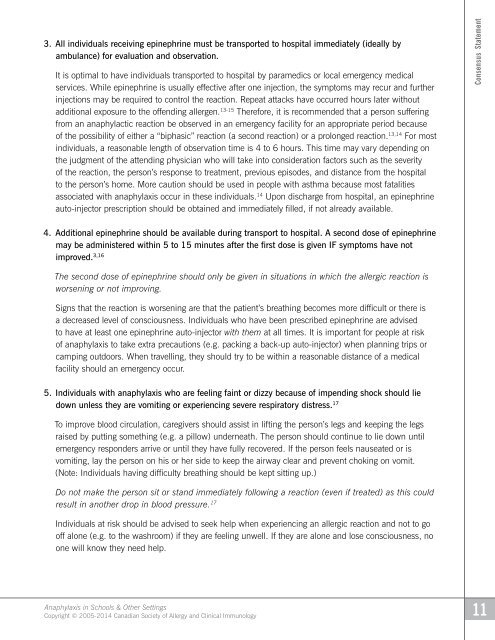Anaphylaxis in Schools 3rd Edition
Anaphylaxis in Schools 3rd Edition
Anaphylaxis in Schools 3rd Edition
You also want an ePaper? Increase the reach of your titles
YUMPU automatically turns print PDFs into web optimized ePapers that Google loves.
3. All <strong>in</strong>dividuals receiv<strong>in</strong>g ep<strong>in</strong>ephr<strong>in</strong>e must be transported to hospital immediately (ideally by<br />
ambulance) for evaluation and observation.<br />
It is optimal to have <strong>in</strong>dividuals transported to hospital by paramedics or local emergency medical<br />
services. While ep<strong>in</strong>ephr<strong>in</strong>e is usually effective after one <strong>in</strong>jection, the symptoms may recur and further<br />
<strong>in</strong>jections may be required to control the reaction. Repeat attacks have occurred hours later without<br />
additional exposure to the offend<strong>in</strong>g allergen. 13-15 Therefore, it is recommended that a person suffer<strong>in</strong>g<br />
from an anaphylactic reaction be observed <strong>in</strong> an emergency facility for an appropriate period because<br />
of the possibility of either a “biphasic” reaction (a second reaction) or a prolonged reaction. 13,14 For most<br />
<strong>in</strong>dividuals, a reasonable length of observation time is 4 to 6 hours. This time may vary depend<strong>in</strong>g on<br />
the judgment of the attend<strong>in</strong>g physician who will take <strong>in</strong>to consideration factors such as the severity<br />
of the reaction, the person’s response to treatment, previous episodes, and distance from the hospital<br />
to the person’s home. More caution should be used <strong>in</strong> people with asthma because most fatalities<br />
associated with anaphylaxis occur <strong>in</strong> these <strong>in</strong>dividuals. 14 Upon discharge from hospital, an ep<strong>in</strong>ephr<strong>in</strong>e<br />
auto-<strong>in</strong>jector prescription should be obta<strong>in</strong>ed and immediately filled, if not already available.<br />
Consensus Statement<br />
4. Additional ep<strong>in</strong>ephr<strong>in</strong>e should be available dur<strong>in</strong>g transport to hospital. A second dose of ep<strong>in</strong>ephr<strong>in</strong>e<br />
may be adm<strong>in</strong>istered with<strong>in</strong> 5 to 15 m<strong>in</strong>utes after the first dose is given IF symptoms have not<br />
improved. 3,16<br />
The second dose of ep<strong>in</strong>ephr<strong>in</strong>e should only be given <strong>in</strong> situations <strong>in</strong> which the allergic reaction is<br />
worsen<strong>in</strong>g or not improv<strong>in</strong>g.<br />
Signs that the reaction is worsen<strong>in</strong>g are that the patient’s breath<strong>in</strong>g becomes more difficult or there is<br />
a decreased level of consciousness. Individuals who have been prescribed ep<strong>in</strong>ephr<strong>in</strong>e are advised<br />
to have at least one ep<strong>in</strong>ephr<strong>in</strong>e auto-<strong>in</strong>jector with them at all times. It is important for people at risk<br />
of anaphylaxis to take extra precautions (e.g. pack<strong>in</strong>g a back-up auto-<strong>in</strong>jector) when plann<strong>in</strong>g trips or<br />
camp<strong>in</strong>g outdoors. When travell<strong>in</strong>g, they should try to be with<strong>in</strong> a reasonable distance of a medical<br />
facility should an emergency occur.<br />
5. Individuals with anaphylaxis who are feel<strong>in</strong>g fa<strong>in</strong>t or dizzy because of impend<strong>in</strong>g shock should lie<br />
down unless they are vomit<strong>in</strong>g or experienc<strong>in</strong>g severe respiratory distress. 17<br />
To improve blood circulation, caregivers should assist <strong>in</strong> lift<strong>in</strong>g the person’s legs and keep<strong>in</strong>g the legs<br />
raised by putt<strong>in</strong>g someth<strong>in</strong>g (e.g. a pillow) underneath. The person should cont<strong>in</strong>ue to lie down until<br />
emergency responders arrive or until they have fully recovered. If the person feels nauseated or is<br />
vomit<strong>in</strong>g, lay the person on his or her side to keep the airway clear and prevent chok<strong>in</strong>g on vomit.<br />
(Note: Individuals hav<strong>in</strong>g difficulty breath<strong>in</strong>g should be kept sitt<strong>in</strong>g up.)<br />
Do not make the person sit or stand immediately follow<strong>in</strong>g a reaction (even if treated) as this could<br />
result <strong>in</strong> another drop <strong>in</strong> blood pressure. 17<br />
Individuals at risk should be advised to seek help when experienc<strong>in</strong>g an allergic reaction and not to go<br />
off alone (e.g. to the washroom) if they are feel<strong>in</strong>g unwell. If they are alone and lose consciousness, no<br />
one will know they need help.<br />
<strong>Anaphylaxis</strong> <strong>in</strong> <strong>Schools</strong> & Other Sett<strong>in</strong>gs<br />
Copyright © 2005-2014 Canadian Society of Allergy and Cl<strong>in</strong>ical Immunology 11


